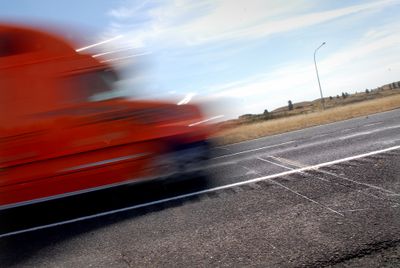Caution, speeders: The road knows

OLYMPIA – So you’re barreling down I-90 past Ritzville, open road ahead, not a state trooper in sight. You give the engine a little gas, then a little more, and soon you’re blasting along at 80 mph.
No one’s watching, right?
Actually, the road itself may be tracking you.
Little-known fact: The state Transportation Department has installed nearly 150 electrical circuits under Washington’s highways during the past couple of decades. Linked to roadside computers, the electronics measure the speed of every car that roars by. The data is used in highway design and to determine where state troopers will be waiting next time you roar by.
Among the dozens of sites measured, the place with the highest percentage of really fast speeders – those who drive faster than 90 mph – is near Coulee City, on State Route 2. The speed limit there is 65.
Because traffic there is thin, the actual number of extreme speeders is modest: a couple hundred cars a year.
But on high-volume highways, the numbers can be striking. The second-highest percentage of high speeders in on Interstate 90 is near North Bend, east of Seattle. In the first four months of this year, nearly 5,000 cars there were clocked going at least 90.
Some Eastern Washington high-speed hot spots:
•I-90 between Fishtrap and Tyler, south of Medical Lake.
•Both I-90 and U.S. 395 in the Ritzville area.
•I-90 at Moses Lake.
•I-90 at Cle Elum.
•State Route 26 near Othello.
•State Route 395 at Eltopia, north of Kennewick.
Earlier this year, troopers scanning the data found that a newly built section of State Route 240 between Kennewick and Richland was drawing a high percentage of speeders. More than 80 percent of the cars on the 60 mph road were speeding.
Troopers in unmarked cars, in aircraft and on motorcycles cracked down, and it seems to have worked, said Washington State Patrol Sgt. Al Escalera.
“That data from those counters gives us an idea what’s actually happening there when we can’t be there 24 hours a day, seven days a week,” he said. “It’s really helped us a lot.”
The data also suggest that the speed “limit” seems to function as a recommended speed. On average, more than half of the motorists on 60 mph highways are speeding.
The speed-tracking technology is similar to what’s under the pavement in front of many stoplights. Metal in vehicles breaks the electronic field, triggering the sensor. At stoplights, this triggers a green light. On the highway, pairs of sensors measure speed.
The tracking dates to the late 1970s, when Congress approved a 55 mph national speed limit to save gas. To show compliance, states had to install sensors and report the data to federal officials.
Jim Hawkins, a state transportation specialist, says the numbers show little change in driving habits over the years, with one exception. High gas prices don’t seem to be making people slow down, he said, but they seem to have reduced the number of cars on the road.
He said the sensors haven’t been used to target individual speeders, although it likely would be possible with the right equipment.
“The technology is right around the corner,” he said. A WSP spokesman, Sgt. Freddy Williams, said troopers don’t have that capability.
Hawkins said the devices are placed in open-road stretches of highway, rather than in congested urban freeways. That gives the best picture of drivers’ true behavior, without traffic jams to skew the numbers.
After all, he said, “you can only go as fast as the guy in front of you.”